I was annoyed Tuesday when the Biden-Harris tribute to the 400,000 fallen included that old, mm…, warhorse “Amazing Grace.” I muttered to my wife Andrea Carney, “Well, as long as they don’t trot out ‘Hallelujah’…,” which of course they did. “Amazing Grace” showed up time and again during the inaugural spectacle.
Continue reading “The Old Normal”Mike Pence Was Right
Now that I’ve got your attention…
No, this is not about the Vice President declining PPE. (Hell, how could the Mayo Clinic afford to jeopardize its bankroll?)
Continue reading “Mike Pence Was Right”Death be not proud: We’ve Been Here Before
There were varied responses to an earlier pandemic, and I first read the following poem in a 1989 collection, Poets for Life: 76 Poets Respond to AIDS. David Kalstone was James Merrill’s friend whose study of Elizabeth Bishop, Marianne Moore, and Robert Lowell was cut short by his death in 1986. Caro is an Italian endearment.
There were varied responses. What are our varied ways today? How to be in solidarity in a time of distancing?
Continue reading “Death be not proud: We’ve Been Here Before”Summerhill 1: Ollie Haskell
In November I spoke with my niece and told her I’ve been telling my stories here. She immediately responded, “Write about Summerhill.” So I will.
Continue reading “Summerhill 1: Ollie Haskell”Rosenberg Resistance
The year 2003 marked the fiftieth anniversary of the execution of Julius and Ethel Rosenberg. Their killing had a great impact on my wife Andrea Carney (see Part 1 and Part 2 of our trilogy). Somehow I learned that a major commemoration would be held in New York City on June 19, the same day they were killed. It was produced by the Rosenberg Fund for Children, founded in 1990 by the Rosenbergs’ son Robert, who was grateful for the support he and his brother Michael had been shown during the jailing of, and after the killing of, their parents. The fund’s purpose is “to find and help children today who are enduring the same kind of nightmare he endured as a child.”1
Continue reading “Rosenberg Resistance”Reopening the Rosenbergs
Note: This is the second in a series of my recollections about Julius and Ethel Rosenberg who were executed in 1953. See Part 1 and Part 3. My husband David Hughes contributed much research and text to what follows.
On February 2, 1975 my then-husband and I were given tickets to an event titled The Julius & Ethel Rosenberg Case: Reopening the Past in Light of the Present at the Santa Monica Civic Auditorium.2
One month before, Congress had passed—over Gerald Ford’s veto—the Privacy Act of 1974, which amended the original Freedom of Information Act of 1966. “This [new] law,” the Christian Science Monitor reported, “provides, among other things, for judicial review of classified national security data to decide if it should be held from public view.” The hope was that—via judicial intervention if need be—previously withheld exculpatory information about the Rosenbergs would be forthcoming from the FBI, CIA, and AEC.3
On stage that night in Santa Monica were Helen Sobell, wife of the Rosenbergs’ codefendant Morton, and Harold Urey, whose telegram to Eisenhower I mentioned last time. “Dr. Urey spoke first,” according to attendee and L.A. Times reader Nina Hammer. “With brief eloquence,” wrote a second attendee/reader Max Lent, “Dr. Urey shot down the conspiracy theory and made it clear that not only were the Rosenbergs innocent of stealing ‘the secret of the atomic bomb’—but no such secret ever existed.”4
Also present were Michael and Robert Meeropol, the orphaned Rosenberg sons who had been shuttled between their grandmothers, an orphanage, family friends, a shelter, and finally were adopted in 1957 by Abel Meeropol,5
who happened to have composed lyrics and songs like “Strange Fruit” (made popular by Billie Holiday), “The House I Live In” (a hit for Frank Sinatra with music by Earl Robinson), and “Apples, Peaches and Cherries” (a hit for Peggy Lee). Michael and Robert had remained relatively anonymous until publication by Louis Nizer in 1973 of The Implosion Conspiracy. Nizer’s “characterization of our parents as political fanatics who neglected us for political causes infuriated us,” and so the Meeropols sued, effectively “going public” earlier than they had wished.6
Scheduled and/or on hand at the February 2 event to provide dramatic entertainment were Susan Anspach (Five Easy Pieces), Herschel Bernardi (Peter Gunn), Peter Bonerz (Bob Newhart), Eileen Brennan, Roscoe Lee Browne, Terry Carter (Phil Silvers), Nina Foch (Ten Commandments, Executive Suite, Spartacus), Henry Fonda, Lee Grant, Phil Ochs, John Randolph (blacklisted in Hollywood between ’48 and ’66), Earl Robinson (whose Ballad for Americans had been used at the 1940 conventions of both the Republican and Communist parties7), Martin Sheen, Jack Warden, and James Whitmore among others.8
Sick to My Stomach
We took our seats in the eleventh row, a few seats in from the right aisle on the west side, so we had a great view amongst three thousand other attendees. The program was still getting underway when I heard something zooming through the air on our right, then a bang and explosion. Audience members in front of us began leaving and I wondered why. Then the tear gas hit me. Those on stage urged people to exit, but not to leave the venue.
Being a Herald Examiner subscriber at the time I hadn’t known until now that freelance writer and L.A. Times drama critic Lawrence Christon wrote about the event and incident in a lengthy February 7 article, and I’ll use it as a springboard for my thoughts, beginning with the tear gas:
[Roscoe Lee] Browne had been reading telegrams of support for about five or six minutes when a small explosion sounded, like a gunshot. Then there was a tinkling of glass to the right, high above my seat. In a flurry, the audience looked around to see if anyone was hurt. No one was. Perhaps a light bulb had broken, for there was a cloud of smoke high above us. And the sound of glass. Bu[t] why the smell of gunpowder?
Then it hit. We didn’t know, of course, that it was simply tear gas—a lot of it.9
According to a transcript of the event’s printed program, Earl Robinson was scheduled to open the entertainment with his setting of a poem by Carl Sandburg. Robinson recalled the incident in his autobiography:
Just as my piece “In the Folded and Quiet Yesterdays” from The People, Yes had begun, a fantastic crash landed on the stage. We thought maybe a spotlight had fallen. Then we smelled gas, which started burning our eyes and skin.10
The next day the Santa Monica Evening Outlook reported that a “doorman said a man and woman burst through a door near the stage just before the bomb went off, carrying an unidentified object” that was “thrown from about the 12th row on the west side of the auditorium”—right behind us! (The two fled the scene immediately.) “Santa Monica police officer John Miehle said the fragmentation-type gas device apparently was about the size of a baseball and contained a powdery substance that formed gas when it broke.” Miehle said it was a “ceramic-covered” device.
Witnesses said it broke over the head of actor Roscoe Lee Brown and actress Lee Grant, who were on stage at the time.
Some fragments of the device hit the head of Earl Robinson […] who was seated at the piano, according to a newsman who was on the scene.11
My husband and I ran out in the rain and I got sick to my stomach. We returned to our seats but the program wasn’t resumed because the fire department said it would take too long to clear the auditorium of the gas. I remember talking with people who thought the police must have been behind it. This is reflected in comments by Robert Carl Cohen, who produced the event and who we spoke with recently: “As if forewarned, within minutes Santa Monica police & firemen wearing gas masks & equipped with portable ventilator fans appeared—telling the dazed & sickened crowd huddling for shelter in the outer lobby: ‘The show’s over—go home.’”
We decided to leave.
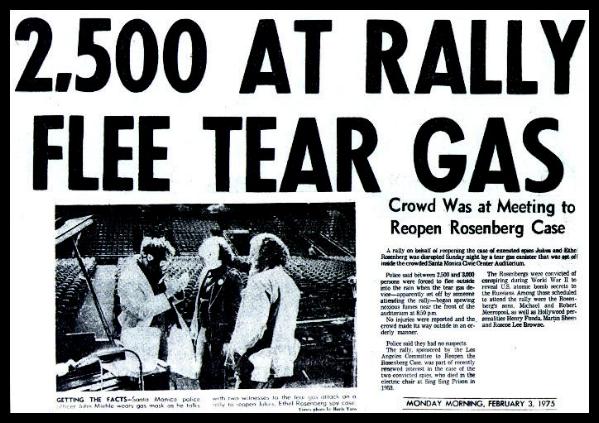
The Show Must Did Go On (and On)
The show went on—after an hour.12
In his L.A. Times article Lawrence Christon writes how twenty-two “entertainers and actors filed out onstage before a line of floor mikes and reading stands,” receiving a standing ovation from the thousand who remained in the audience. They read “a historical summary beginning with the first detonation of the atom bomb over Hiroshima and culminating in the 14-day trial that led to the execution of Julius and Ethel Rosenberg for conspiracy to commit espionage, on June 19, 1953.”
In the following film (at 14:19) the event’s producer Robert Carl Cohen and participant Lee Grant describe for themselves the tear-gassing and the performers’ return to the stage.
[Note: The film ceased streaming via the service SnagFilms when it closed operations in the spring of 2020. It currently is available for streaming via Amazon Prime Video.]
After the dramatic reading, Phil Ochs sang his “There But For Fortune,” which Christon called “quiet and thoughtful, as was the message of several others in the course of the program.” Not so Helen Sobell, who “spoke of the case in harsh terms,” using phrases like “liberating the oppressed of the world” and “attacking the soft underbelly of the monster.” She referred to “U.S. imperialists” and “the Fascists who threw that,” indicating where the tear gas had gone off. Christon wrote that the audience knew “a demagogue” when they heard one. “The mood of the crowd began to shift subtly.” And “they knew that demagoguery was the last thing they wanted, the last thing that could serve them.”
Sobell was followed by Isabel Chavez, “a young, slenderly attractive, middle-class-looking Chicano girl, [who] walked on and began hollering into the mike about ‘Los Tres’ (three Chicano defendants in a drug case),” which caused “a number of people” to get up and leave. “Most of the audience was unfamiliar with the case, and her charge that police wanted to keep drugs in the barrio for purposes of oppression seemed, on the surface, bizarre.” (The aforementioned attendee Max Lent also mentioned “wearisome harangues from the stage.”)
Critic Christon had been dispatched by his editor likely due to the all-star lineup of the program. But he wasn’t even sure of that, asking somewhat rhetorically:
[S]o was I to comment on the entertainment? Gauge the program’s dramatic effects? Or was my duty something more subtle and complex: to attempt to measure how a Theater of Fact, or a Happening (both terms of relatively recent coinage designed to capture the essence of the volatile relationship between history and art) could enlighten and move an audience to a certain, shall we say, truth?
Christon remarked that the audience
was, essentially, an older, affluent Jewish crowd. The Rosenberg case links them to a different era. McCarthyism. The Bomb. Korea. The Age of Anxiety. That was a bad time for minorities and dissidents and, psychologically, even worse for a people not far removed from the death camps of Europe. What could a Jew have thought of 1953’s news headlines calling the Rosenberg case ‘the crime of the century’? How could the alleged passing of atomic bomb secrets to the Russians compare with Hitler’s atrocities?
So Christon appeared to be thoughtful but became uncomfortable at the rage of Helen Sobell, the only speaker thus far to have been personally impacted by the case, her husband Morton having been imprisoned for 18½ years. She had raised over $1 million to fund the filing of eight legal appeals—all unsuccessful—prior to his release in 1969. Upon her death, Morton told the L.A. Times that Helen wasn’t the fighting type before his arrest, but “she developed into one. … There are people who rise to the occasion and she was one of them.”13
Christon wrote that Helen “spoke as though she were an elementary school teacher berating her class for unspeakable behavior.” (And so she is a forebear of Greta Thunberg.) Helen was in fact a teacher (and a scientist whose work on the computer language Unix was acknowledged by her son Mark years later). Unlike Christon, Morton himself didn’t—indeed couldn’t—regard the Rosenberg case as an artifact of a “different era”: he was on parole for six more years. “If the day before it is up, they say I’ve stepped out of line,” Morton said in 1974, “I’m liable to serve the remaining 12 years of my sentence.” Continuing, he addressed the fact that he’d spoken at a recent Carnegie Hall rally to reopen the Rosenberg case by saying, “My primary political activity is trying to make people aware that we have political trials in this country” such as those regarding the Attica rebellion of 1971 and the Wounded Knee occupation of 1973.14 (For these “minorities and dissidents,” at least, it still was “a bad time,” as Christon had written about that “different era.” See my post Attica: Coming Together.)
As for Helen, the threat of fascism in the ’40s and ’50s, which motivated many American communists and fellow travelers, came home in the ’70s when responsibility for that February 2 tear gas attack at the Santa Monica Civic was claimed by actual fascists, as Earl Robinson recalled:
A man from some neo-Nazi group called “the provisional wing of the National Socialist Liberation Front” telephoned a news office claiming responsibility. The bomb squad said it was “the type of bomb used to get the Viet gooks out of their tunnels,” something not commonly available to anyone but law enforcement or military.15
As of that night, neither Sobell nor Christon could have known for certain whether it was neo-Nazis who had disrupted the event we attended. But indeed they had. Just as Robinson had recalled, the day after the event, at 2:30 p.m. on February 3, the local City News Service received a call saying, “The attack on the Rosenberg rally last night was carried out by the Provisional Wing of the National Socialist Liberation Front. We will continue to disrupt the love affair between the Communists and the media.” This was reported by the Evening Outlook on February 4.16 Two days later on the 6th CNS got a second call by the same neo-Nazi group at 3:30 p.m. claiming responsibility for two bombings of socialist entities that had occurred on the 4th. “We don’t want to harass the Socialists,” the caller said, “we want to exterminate them.” (Bombed on the 4th had been the office of the Socialist Workers Party on Westlake Avenue, with twenty-five people barely escaping death or injury. Three hours later in East L.A. the unoccupied Unidos Bookstore, run by Maoists, also was bombed.)17
Was the L.A. Times aware of these claims of responsibility on the 3rd and the 6th, prior to Christon’s February 7 article?
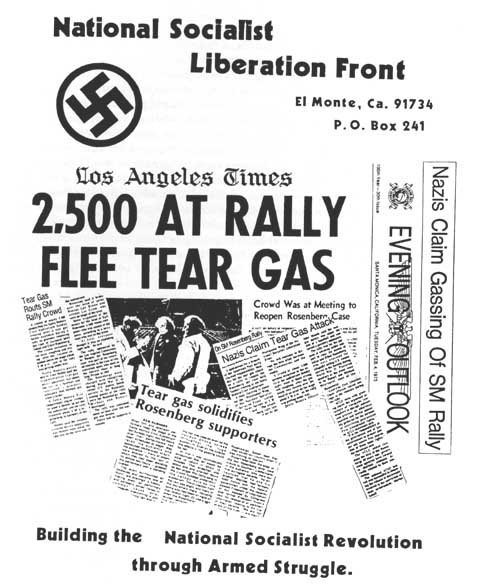
Leading the Nation
Morton Sobell’s one-time attorney Frank J. Donner writes that in 1974 Los Angeles led the nation with a total of 154 bombings and “[i]n the first five months of 1975, no fewer than 18 terrorist-style bombings took place in the Los Angeles area […].”18 And coincidentally:
In April 1975 the Los Angeles Police Commission announced the planned destruction of some 2 million secret police intelligence files kept on individuals and organizations over the preceding half-century. The files covered the activities of an estimated 55,000 undisclosed individuals and groups and extended, in the words of the commission’s press release, “from the Wobblies of the Twenties to the labor agitators of the Thirties, the interned Nisei of the Forties, the alleged subversives of the Fifties and some antiwar demonstrators of the Sixties.”19
Again, this may echo the bygone “era” that Christon references, but Donner goes on to explain that the department’s Public Disorder Intelligence Division, which had amassed those files, continued its work. Yet out of the eighteen incidents in early 1975 only one arrest was made—a member of the Jewish Defense League—despite the National Socialist Liberation Front admitting to the Rosenberg and SWP incidents.20 The National Socialist Liberation Front’s leader Joe Tommasi told the Los Angeles Free Press that LAPD’s Criminal Conspiracy Section “want to bust me like mad,” but despite putting “thousands of man hours” into the incidents, they “don’t have a thing to go on.”21
“On the surface, bizarre”
Which brings us to the case of Los Tres (del Barrio). Evidently someone in the reopen-the-Rosenbergs group had felt that a local, current travesty of justice might be in order, even if its spokesperson was out of order, as characterized by L.A. Times critic Lawrence Christon and his reader Max Lent.
The case involved a federal narc, Robert Canales, who in July of 1971 tried to buy drugs in an East L.A. housing project. Guns were brandished and Canales ended up shot and paralyzed. The L.A. Times covered only the arrest, conviction, and sentencing of the three defendants, Los Tres (Alberto Ortiz, Juan Ramon Fernandez, and Rodolfo Pena Sanchez), summarizing their defense in the latter two articles:
The three testified that they thought Canales was a narcotics dealer and had hoped to scare him out of East Los Angeles. They said they were members of a community action group called La Casa de Carnalismo.
One of the main concerns of Casa de Carnalismo, according to spokesmen, is to clean the drug traffic out of East Los Angeles.22
A 1970 L.A. Times profile of Jorge Rodriguez, a high school student militant, describes the inception of “Carnalismo—the brotherhood—formerly known as Fourth Flats Gang”:
[The Rodriguezes] got the gang a clubhouse where classes in Mexican art, history and dance are now available to some 50 youngsters ages 12 through 18.
Carnalismo’s aims include keeping its members off the streets, out of gang fights and away from narcotics.23
Lawrence Christon claimed that Los Tres spokesperson Isabel Chavez’s “charge that police wanted to keep drugs in the barrio for purposes of oppression seemed, on the surface, bizarre.” But one needs not look too far below that surface to be struck by LAPD’s long history of oppression, wielded by cops in their positions of power—from quotidian brutality to shootings to, yes, drug dealing.
In 2015 my husband David Hughes did a simple study of newspaper reports that focused only on the department’s brutality cases.
My survey was bookended with “Bloody Christmas” incidents beginning in 1909 (a drunken bricklayer on his walk home severely beaten after shooting an officer in the thigh) and ending with the notorious, systematic sadism of 1951 (backdrop to James Ellroy’s L.A. Confidential novel and film adaptation).
When David and I left L.A. for Denver in 2005, LAPD was in the fourth of nearly a dozen years of a consent decree with the Justice Department.24 It began with the 1998 arrest of anti-gang unit officer Rafael Pérez: a cop stealing evidence-room coke exploded into an exposé of corruption and misconduct, as the L.A. Times reported on New Year’s Eve 1999.
In ensuing weeks, detectives put boxes of Perez’s old case files in front of the ex-cop during lengthy debriefings at a secret location. Perez told investigators that he and his partner, Nino Durden, had so often planted drugs or otherwise framed suspects that he needed to see the files to be reminded of all the tainted cases, according to sources.
As many as thirty officers were expected to be fired.
To date, what has become known as the Rampart corruption scandal includes allegations of “bad” shootings, beatings, drug dealing, evidence planting, false arrest, witness intimidation and perjury.25
So when David and I read this week that Lawrence Christon thought Isabel Chavez’s charge that LAPD “wanted to keep drugs in the barrio for purposes of oppression seemed, on the surface, bizarre,” we found it anything but astonishing, although the “purposes” might have differed from wave to wave of LAPD malfeasance. As of 1975, however, those purposes ring true.
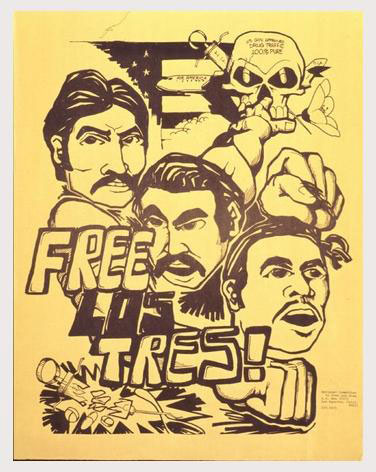
At the time of the Santa Monica Civic tear-gassing, one Michael Craig Ruppert was an LAPD cop doing narcotics work.26 In December 1975 he met and later became engaged to a CIA agent who “had made it clear that her people were focused entirely on a guns-for-drugs trade, and that they had no interest in stopping or seizing certain narcotics shipments,” as Ruppert writes in a 2010 online bio. It actually was a drugs-for-guns operation, with heroin proceeds purchasing guns—bound for Iran. His fiancée urged him to participate as a CIA operative in the guise of an LAPD detective.
Once it became clear to me that I would be asked to allow narcotics to be delivered to the street, I flatly and categorically refused. It would have been a violation of a code of honor which had been deeply instilled in me. Within short order my fiancée disappeared, and I was to spend the last two years of my five-year tenure at the Police Department in constant fear. It had been revealed, and was to be confirmed years later, that, throughout its history, the CIA had routinely contracted key personnel in major police departments around the country and also placed CIA officers under cover as a standard procedure, even though it was illegal.
Ruppert left the LAPD in 1978.27 Was this a case of CIA overreach without LAPD complicity? Eighteen years later, in a Los Angeles high school town hall, Ruppert declared publicly what he knew about an LAPD–CIA drug dealing connection.
At the Santa Monica Civic Helen Sobell sounded like an overeager evangelist, finding a fascist under every flagstone. Isabel Chavez was a conspiracy theorist accusing LAPD of keeping drugs in “East Los” for the purposes of oppression. I can identify with both of these women.
Cleaning Out J. Edgar’s Attic
With the enhancement of the Freedom of Information Act, signed into law on New Year’s Eve 1974, government documents regarding the Rosenbergs began to be produced, not only to the Rosenberg sons but also to scholars and the press. As early as May 1975 a FOIA request resulted in Newsday declaring that new materials “provide the first documentary evidence of an apparent agreement among high government and law enforcement officials to manipulate the testimony against the Rosenbergs in the interest of making ‘A big case’—as one participant put it—and securing a death sentence.”28 In August a request filed three years before by Smith College history professor Allen Weinstein was answered by the FBI with 725 pages out of its 48,000-page file on the Rosenbergs.29 Three months later the Rosenberg sons were offered 29,900 pages of FBI files for a labor cost of $23,451.80, and 953 pages from the CIA for a cost of $14,155.30.30
The files were released in dribs and drabs. For every revelation unfavorable to the government—for instance, that the FBI had listened to Julius’s pre-trial attorney–client sessions—there was another that incriminated the accused—e.g., that Julius “allegedly described in rich detail […] his record as a recruiter of spies” to a cellmate snitch who, upon release, become chauffeur to Rosenberg attorney Emanuel Bloch, informing all the way.31
Twenty years later, on July 11, 1995 the first batch of Venona messages—decoded Soviet communications from the early 1940s—were made public by the NSA. Writing about the release at the time for the L.A. Times, staff reporter James Risen (!) states that “the FBI’s investigation of the Rosenbergs was prompted by top-secret—and damning—intelligence never mentioned in the trial […].”32
Writing a month later in The Nation were Walter and Miriam Schneir, who had published four editions of their Invitation to an Inquest, each of which “concluded that the Rosenbergs were ‘unjustly convicted’ and ‘punished for a crime that never occurred’”—the last edition in 1983. These viewpoints shifted only slightly vis-à-vis the Venona docs, which “corroborate only a relatively minor role in atomic espionage for Julius” but “reveal that during World War II Julius ran a spy ring” that “gave technical data […] on radar and airplanes” that were forwarded to the Soviets. These “nonatomic espionage activities” had been charged at the trial but the government focused on atomic secrets. The Schneirs end their article by explaining that the CPUSA was linked to the KGB, a fact “certainly not known to most rank-and-file members” but demonstrated by “[a] fragmentary but astonishing message from Moscow dated April 5, 1945” that refers to information given by Julius to what appears to be leadership of the CPUSA.33
All of the dirt that came out on Julius Rosenberg didn’t make me happy, but it didn’t really bother me. His spying was done on behalf of a U.S. ally. It could be seen as leveling an intellectual playing field. I know: Donald Trump is a moral relativist too…
Next time: The 50th anniversary of the Rosenberg executions, held in New York City.
Header image:
Memorandum from
Helen Sobell’s FBI file
dated 18 days prior to the
Santa Monica Civic event
Notes
Observing the Sabbath: Killing the Rosenbergs
Note: See also Part 2 and Part 3 of this trilogy.
As early as I can remember I was placed in front of the radio (we had no television). I was exposed to music, advertisements, dramas, and news. At age three I tried to read newspapers. I simply wanted to read about what I’d heard. By the age of five I was reading the “briefs” in the back pages because they were easier for me, but they also could lead me to bigger stories. In particular I remember reading briefs about spies.
I was eight years old in 1950 when Julius and Ethel Rosenberg were arrested on an eventual charge of—not espionage—but rather conspiracy to commit espionage. Their co-conspirator Morton Sobell also was arrested (while in Mexico during which time Julius was arrested).15 Julius had been implicated by Ethel’s brother, David Greenglass, who said at trial that in September 1945 he’d given Julius a nuclear bomb diagram as well as verbal scientific secrets, typed up by Ethel,34 which presumably were transferred to the Soviet Union.
What upset me at first was my concern for the Rosenbergs’ sons. Michael was seven and Robert was three. Ethel had been arrested two weeks before my ninth birthday, at 1:15 on the afternoon of August 11, 1950, after appearing before a grand jury. Arraigned at 4:00, she was denied parole over the weekend to make arrangements for her boys—despite the Jewish Sabbath, which began four hours later, at sunset.35
Ethel’s brother David was the star witness at trial. She and Julius pled the Fifth, refusing to name names, and were convicted by a jury and sentenced to death by the judge, Irving Kaufman, who gave Sobell thirty years and David fifteen.
Spies Optional
I distinctly remember reading that the scientific information the Rosenbergs supposedly obtained was common knowledge and had appeared in textbooks—in Russian! I can’t confirm that now, but at their April 5, 1951 sentence hearing their attorney Emanuel Bloch “read excerpts from a Yale Law Journal article that held that the Soviet Union would have perfected atomic weapons in due course, with or without the help of spies […],” according to historians Ronald Radosh and Joyce Milton.36
The following passage gives a sense of the article’s substance:
While it may be possible to safeguard information against coming into the possession of foreign scientists and thus reduce leaks to countries which may be our enemies in future wars, this cannot be achieved without restricting the free exchange of ideas among our own scientists. Is there, then, a middle way which science and national security can travel together without seriously impeding each other? Many of our leading scientists believe not.37
This was published in 1947.
All-Points Bulletin
A four-page bulletin in support of the Rosenbergs (pictured below), which I hadn’t seen until today, confirms my recollection about the availability of the science. It states that “the government time and time again announced that the ‘secret’ of the A-bomb was no secret,” and that “the plans Greenglass made proved [to be] ‘downright unworkable,’ and ‘made little scientific sense,’ according to Life and Time magazines.”38
I found both those articles today. They’re dated March 26, 1951—just before the Rosenbergs’ conviction on the 29th.
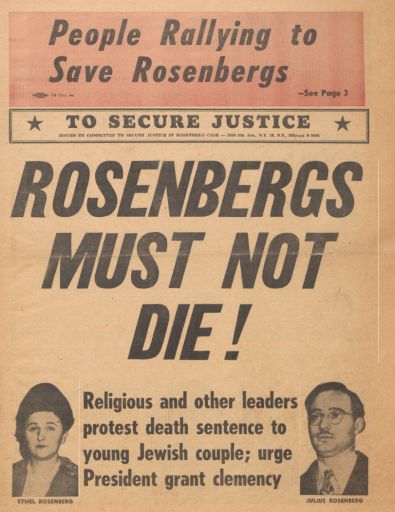
In the Life article, titled “Spy’s Version of the A-Bomb: This is what Sergeant Greenglass had given the Russians in 1945,” the writer states, “At first glance Greenglass’s implosion bomb appears illogical, if not downright unworkable. There seem to be two things wrong with it.”39
Time’s article—“The Greenglass Mechanism”—states that “Greenglass is no scientist (at Brooklyn Polytechnic Institute he flunked eight courses out of eight), and some of his testimony made little scientific sense.”40 (The next month, Life published another article, “The Case of the World’s Greatest Secret,” which contends that “even without Greenglass, Russia had more expert and highly placed sources within the international group of physicists working on the bomb.”41)
Finally, the Rosenbergs bulletin quotes the “Smyth Report”—a document commissioned by the Manhattan Project—which was released publicly on August 12, 1945, just three days after the bombing of Nagasaki:
13.2. A weapon has been developed that is potentially destructive beyond the wildest nightmares of the imagination; a weapon so ideally suited to sudden unannounced attack that a country’s major cities might be destroyed overnight by an ostensibly friendly power. This weapon has been created not by the devilish inspiration of some warped genius but by the arduous labor of thousands of normal men and women working for the safety of their country. Many of the principles that have been used were well known to the international scientific world in 1940.42
The Big One
On July 21, 1952, just before 5 a.m., I was awakened abruptly. “Why are you shaking the bed?” my sister asked. “I’m not,” I replied. “Look outside!” Bright red and blue flashes lit up the sky. “The Russians are bombing us,” I thought to myself. “It’s an earthquake!” our parents yelled. “Run into the hallway.” But I didn’t believe it. I did as I’d been trained to do: duck and cover. It was pitch black because we’d lost electricity. “Where’s Andrea?” asked my father. “You’re standing on me!” I cried.
That was the Tehachapi earthquake, the strongest in California since San Francisco’s in 1906.
An Open Secret
The Rosenbergs became a cause célèbre after their sentencing, with many luminaries calling for clemency. I especially remember Albert Einstein doing so publicly.43 And I thought it was he who said the nuclear information David Greenglass had given Julius was either well known or worthless.44 But it actually was the chemist Harold Urey, Einstein’s Nobel-winning colleague, who said so in a telegram to President Eisenhower:
Greenglass is supposed to have revealed to the Russians the “secret” of the atomic bomb. Though the information supposed to have been transmitted could have been important, a man of Greenglass’ capacity is wholly incapable of transmitting the physics, chemistry and mathematics of the atomic bomb to anyone.45
That telegram was made public on Friday, June 12, 1953—six days before the Rosenbergs were scheduled to be executed. Although I don’t remember seeing an ad like the one below, which appeared in the L.A. Times on the 16th, I do remember reading about how the sons would be orphaned. I begged my mother to send a telegram to Eisenhower asking him to commute their sentences. (I didn’t know how to do that myself and hadn’t yet started babysitting so I had no extra money.) My mother didn’t even answer me. As I walked away, she just laughed, as if it was a ridiculous thing to ask for. It would have cost about a dollar and sixty cents.46
I went to bed. And I wanted to cry but I didn’t cry about things like that in those days. I pulled the covers over my head and felt sick at heart.
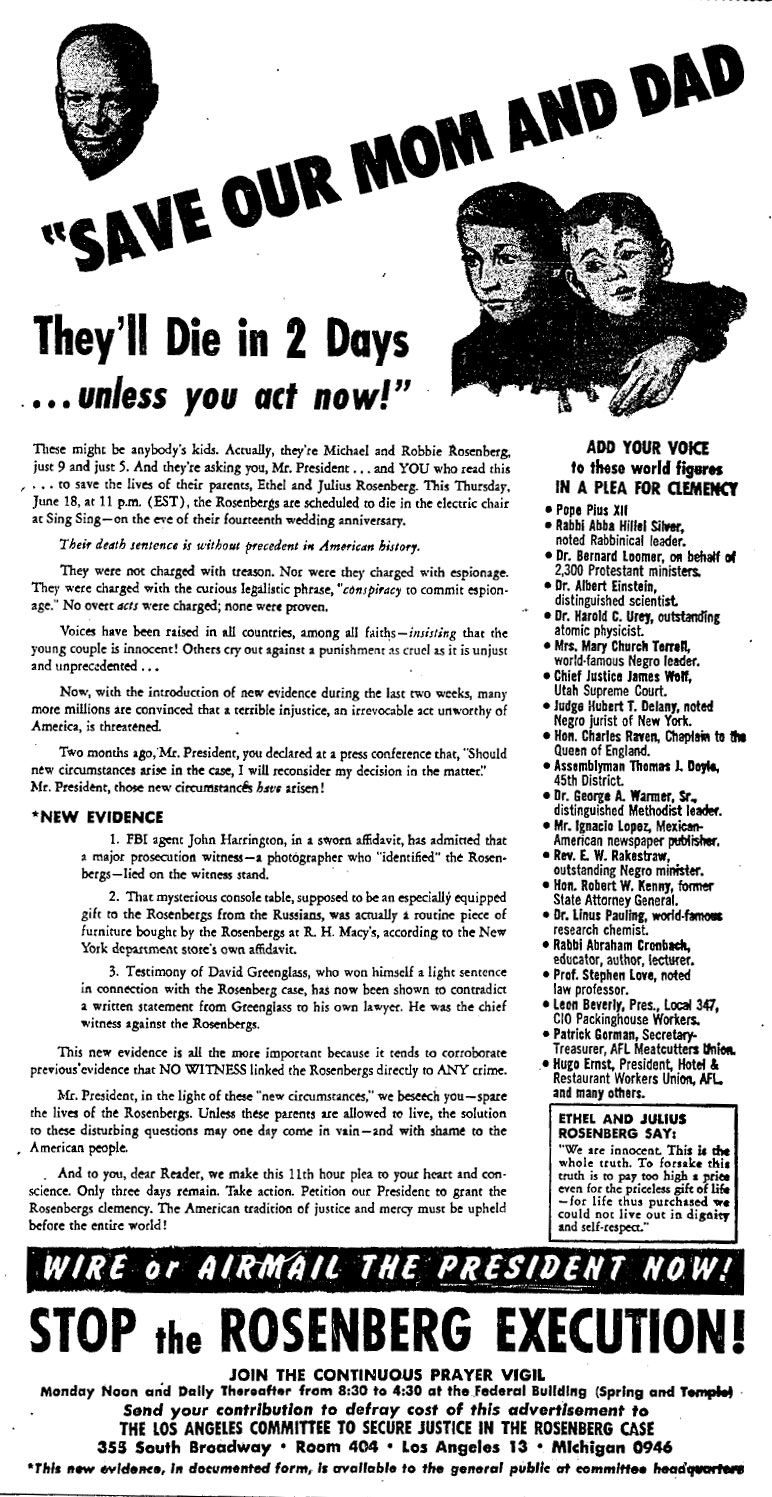
This was my coming-of-age moment, at eleven years old. I realized I had to figure out who I was and who I was going to be. I couldn’t just sit on the sidelines and watch people get hurt. I wanted to be better prepared if anything like that happened again.
Observing the Sabbath
The Rosenbergs were killed the next Friday, June 19, 1953. The executions had been stayed a day by the U.S. Supreme Court due to a last-minute appeal by attorney Fyke Farmer. When that appeal failed, the killings were scheduled for 11:00 p.m., but the defense attorneys protested such acts taking place on the Jewish Sabbath. This also worried Judge Kaufman, who moved up the schedule to 8:00, twenty-nine minutes before sunset.
Header image:
Ethel and Julius Rosenberg
by Roger Higgins, 1951,
after their sentencing,
altered by David Hughes
Notes
Sibling Cities in an Invisible Empire
We’re all familiar with the Charlottesville chant from two years ago: Jews Will Not Replace Us.
It’s a perennial paradox. Torch-bearing worshippers of an almighty God, who answers prayers with miracles, and devotion with salvation, at the same time have an inferiority complex as vast as their numbers. In 2014 the Pew Research Center’s Religious Landscape Study reported that if the U.S. had a population of only 100 (adults) there would be two Jews, one Muslim, and 71 Christians. Verily: Jews will not replace Christians. But what might rightly rile these folks are two other Pew stats: 1) only 47 of those 71 nominal Christians are white and 2) as many young people identify as “unaffiliated” as they do “Protestant.” (Earlier I discussed how sex surveys of young people show that about 1 in 5 don’t ID as straight—about the same percentage as the unaffiliated total in the Pew poll.)
KKKpleton
When my wife Andrea Carney and I first moved to our Denver neighborhood in 2005, Andrea found it was named for a mayor who had profited politically from the prototype of what we saw in Charlottesville. We were heartened in 2015 when Black Lives Matter began an effort to change the name.
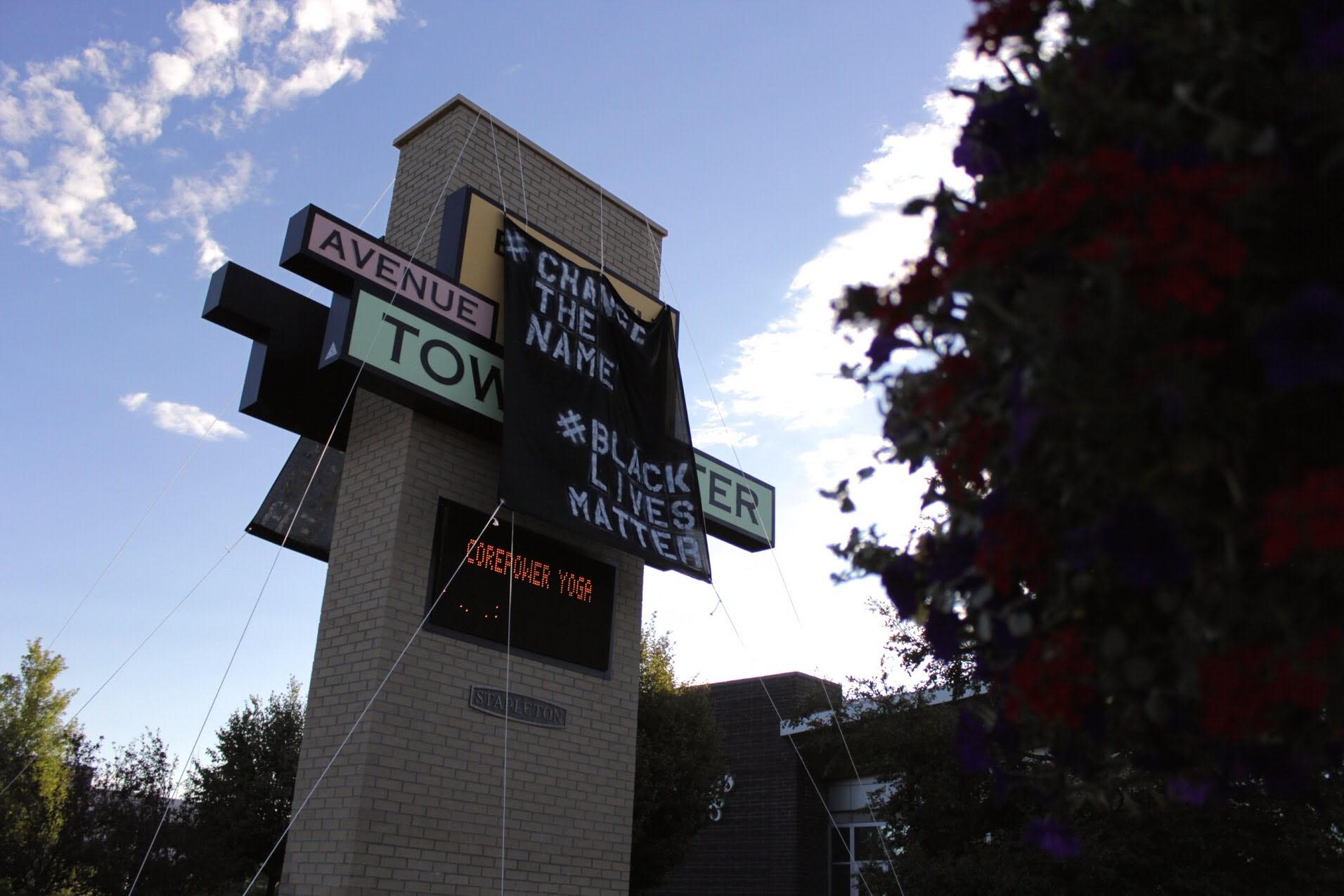
In July of this year, we and our neighbors (property owners only, no renters) voted whether to retain the neighborhood name Stapleton, which we inherited from the former airport on which our plots are platted. (Our true legacy, of course, is from indigenous people, as explained here.)
Continue reading “Sibling Cities in an Invisible Empire”The Summer of Our Discontent
The same edition of Gay & Lesbian Review that I touched on last time—its Stonewall Special—contains an essay by author and publisher John Lauritsen: “The Rise and Fall of the GLF.”47 I reread the piece last month.
Shortly after Stonewall in the summer of ’69 Lauritsen attended a meeting of gay people who were debating whether to align with the antiwar movement, with which John had been involved since 1965. He and the other radicals at the meeting carried the day and so the group eventually was dubbed Gay Liberation Front, a nod to the National Liberation Front—aka Viet Cong—of Vietnam. This is an example of the overlap I always saw as perfectly natural. As a kid I organized against the war in high school and and also wrote a book report on James Baldwin’s Another Country.48 Others might have preferred cubbyholes over connections.
nAIDSayer
I first became acquainted with John Lauritsen’s writing through the pages of the New York Native, a gay biweekly founded by Charles Ortleb, publisher of Christopher Street magazine. I’d been picking it up in L.A. and later subscribing because of its stories critical of the medical establishment’s stance on HIV and AIDS. (Only later would I read that the Native published the first article in the popular press about AIDS, in 1981.49) The Native’s Wikipedia entry features an image of the biweekly’s cover of June 1, 1987, quoting Lauritsen’s critique of AZT. Besides Lauritsen I’d been reading other AIDS renegades like scientist Peter Duesberg, who questioned the role of retroviruses in cancer and AIDS and whom John was the first to interview. (Read about John’s many writings on the subject here.)
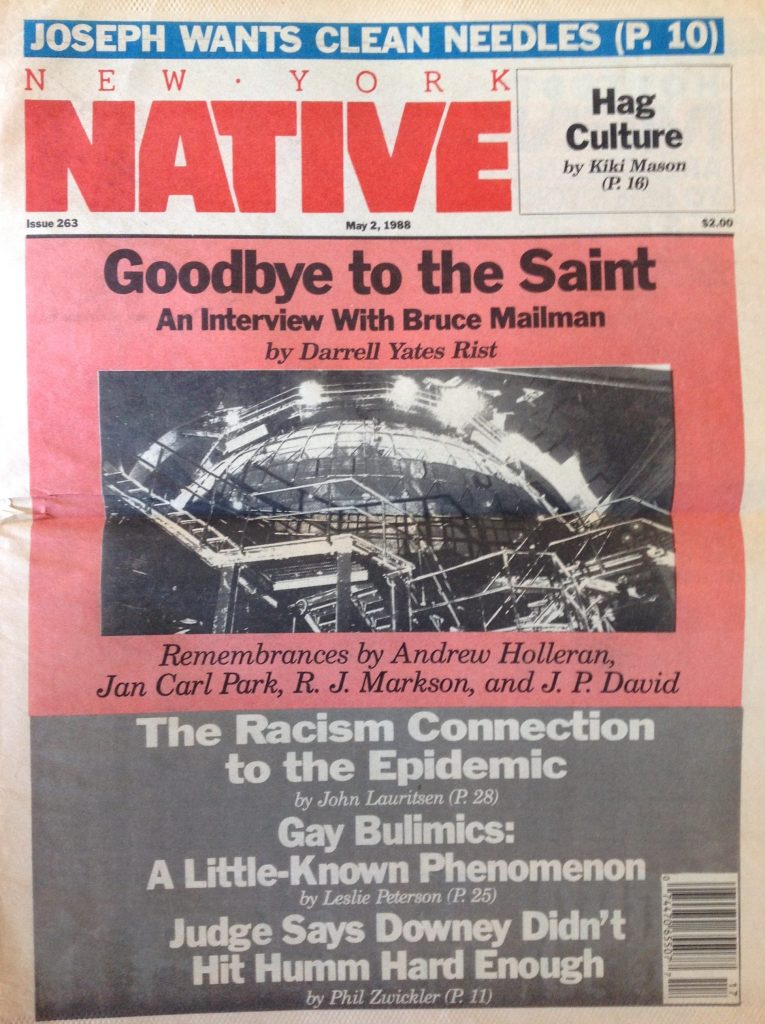
Gay Liberation’s 150th Anniversary
More recently I’ve consulted Lauritsen’s book The Early Homosexual Rights Movement (1864–1935) coauthored with David Thorstad.50
The authors begin by observing that
the Stonewall riots represent not the beginning of gay liberation but the beginning of a new wave of gay liberation. 1969 marks a rebirth, an anniversary—indeed, one might say the 100th anniversary of gay liberation.51
And the authors describe yet another historical overlap—in their chapter Socialism and the Early Gay Movement. It’s a good introduction to an under-appreciated period in the struggle for liberation(s).
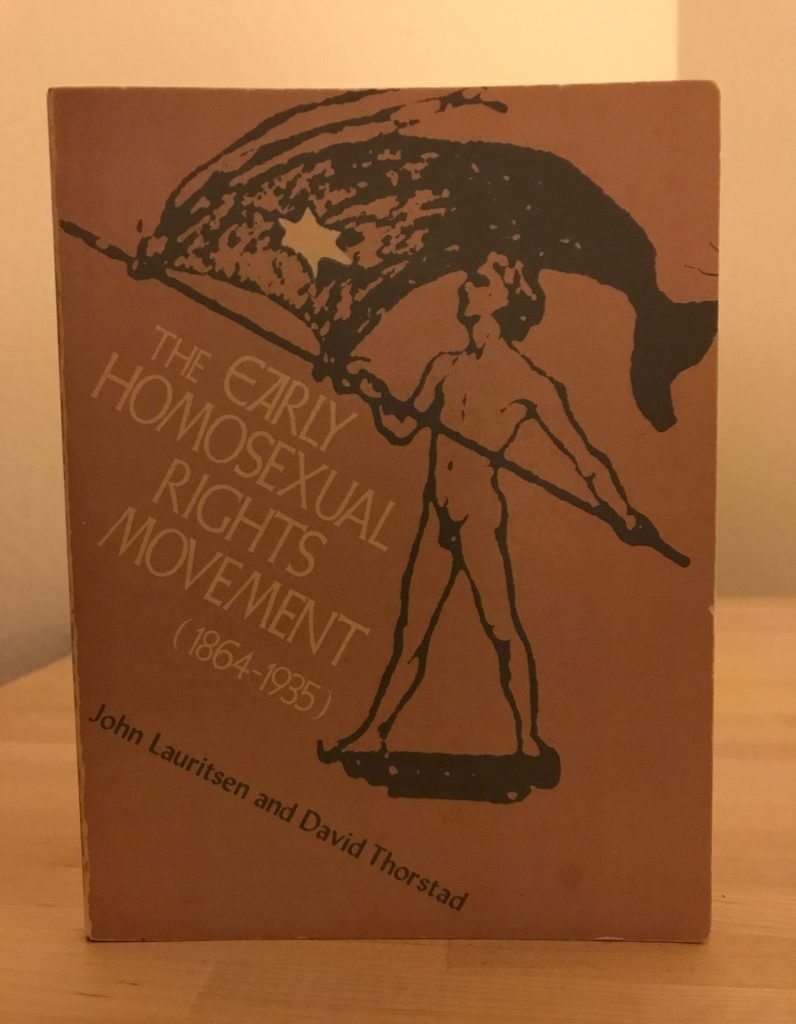
Versus the Voice
On my second reading of Lauritsen’s essay about GLF I took note of what he calls the group’s “first major demonstration.” It was a picket line—not against, say, The New York Times, which forbade the word “gay” until 198752—but against The Village Voice. I was astounded. I’d subscribed to the Voice in the ’80s in order to stay on top of music trends, and I found it to be extremely gay friendly. What a difference a decade makes. And I suspected I might know why GLF had targeted the Voice.
In a footnote to my previous post, Vaniegem and Bubblegum, I mention that one of the two reporters in the Voice’s immediate coverage of Stonewall, Lucian K. Truscott IV, wrote this past February about another, earlier subject: being groped by Cardinal Spellman while trying to interview him for the West Point cadet magazine The Pointer. I kinda forgot about that until rereading Lauritsen, who writes that the GLF picket line was incited in part by the Voice‘s “antigay article about Stonewall.” I wondered if Truscott might have been the author. Fortunately, Google now archives publicly the Voice’s run of 999 editions between 1954 and 2004 (with many holes).
The initial riot reporting is riveting, regardless of subsequent scrutiny. Truscott was joined on the front page of the July 3, 1969 issue by columnist Howard Smith. Truscott—a newly minted West Point grad waiting to report to Fort Benning—was well read enough to compare the first night of Stonewall to a William Burroughs novel. And a “fairy tale.” Apart from the usual mention of limp wrists as well as Truscott’s martial “forces of faggotry” and “gay brigade” the piece is relatively straightforward. As is Smith’s; he actually followed the police into the Stonewall Inn while they waited for reinforcements. Could either of these be the anti-gay story that caused the GLF to picket?
Since I’d corresponded with John Lauritsen in 2012 about an unrelated matter I didn’t hesitate to ask him about this last month. No, the article was penned by Walter Troy Spencer in the July 10 edition of The Village Voice.
Spencer begins that installment of his occasional Last Call column, titled “Too Much My Dear,” with what NBC News in June (2019) called “coincidence” rather than “cause and effect.” And it’s been quoted often, even if Spencer’s source is all but forgotten:
The combination of a full moon and Judy Garland’s funeral was too much for them, Dick Neuweiler said the other day, assessing the cause of the Great Faggot Rebellion.
Spencer strings a strand of tedious complaints lodged over the years anytime people rise up: the inconvenience, the injury to themselves and their businesses, the cops being such great guys (with a sense of humor) and, as Spencer puts it, the “ugliness on both sides.”
Still, why the GLF ire? Reading Spencer today he seems typical of the time. Except that it was The Village Voice. And except that the other motive for GLF’s picket line, explained by Lauritsen in his essay, is that the Voice “refused ads for [a] GLF dance on the grounds that ‘gay’ was a dirty word.” And except that the second page of Truscott’s July 3 article features an ad, reproduced below—innuendo ignored.
Spoiler alert: The GLF demo “was a resounding success,” as Lauritsen writes in his essay. He recounts this and more in deliberate detail in a GayToday.com story from 2004.
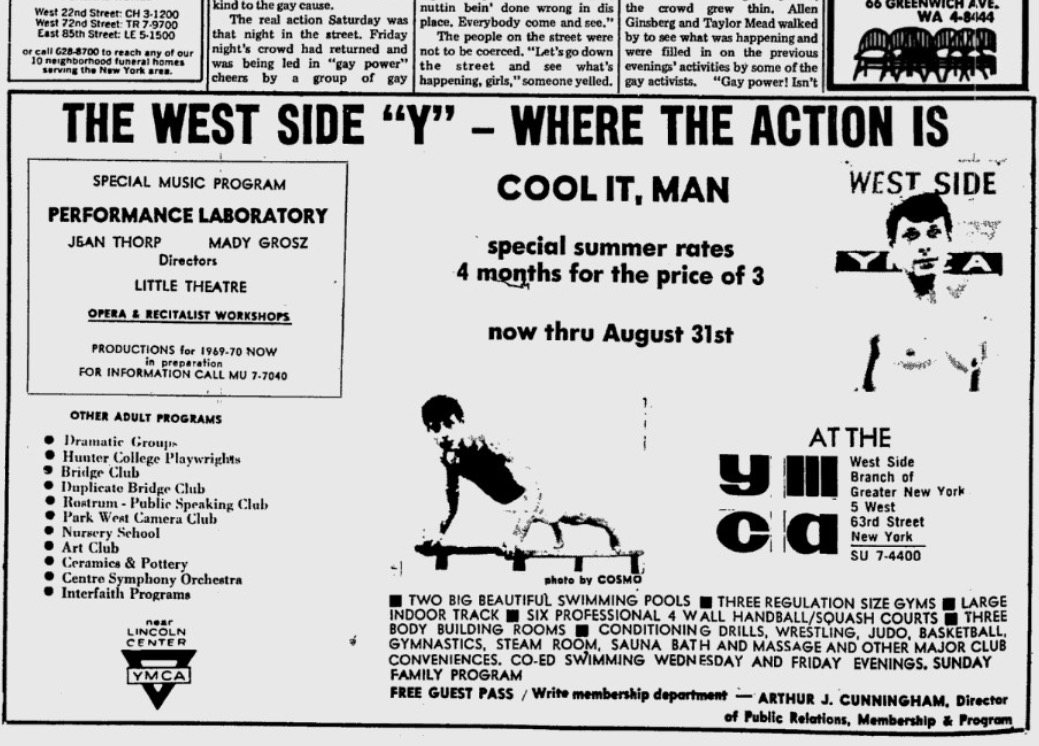
Querying the Q-word
John also sent me a personal reflection on Stonewall’s 50th anniversary in which he argues against adoption of the term “queer.” As he states in the GL&R essay, while the GLF men met night after night to define their aims, they concluded that “gay” should be the preferred term for use by themselves and others—despite any unfamiliarity by the general public. “It was not clinical like ‘homosexual,’ timid like ‘homophile,’ or hateful like ‘queer.’”
Fast forward to a world where “queer” has been embraced from the avenues to academia. One might make a comparison with gay appropriation of the Nazis’ pink triangle a generation ago (not to mention Christians’ embrace of the instrument of crucifixion). But a symbol is not a word, even in this emoji-laden era. I 🔻 You?
The triangle had more than a fifteen-year lead in use and so it seems almost relegated to a bygone era. Not necessarily so for queer. While staffing a booth at the Creating Change conference in 2015 (we offered books from AK Press, an oasis in a desert of NGOs and such) a man older than me came up to the table and remarked that queer to him was a pejorative. Impatient with my inarticulate explanation, a woman younger than me interjected: Suppose I’m a lesbian and have a relationship with a trans* man; gay simply isn’t expressive enough.
Read Lauritsen’s “Stonewall 50 Manifesto: Gay Men Are Not Queers!” and see what you think.
Lauritsen is not alone in his criticism of queer, however, reprinting four other authors’ reflections (and two more of his own). He begins with John Rechy, who himself begins by picking apart the male/female use of the suffixes “-or” and “-ess.” This is a slippier slope than gay/queer because it nearly begins and ends with the terms actor and actress. Rechy writes:
In an excess of purported equality, some Hollywood actresses want to be called “actors.” How sad and self-defeating. Doesn’t opting for the male-designated noun, actor, imply superiority of that male form?
We’re so familiar with these two terms that the switch to which Rechy refers is a jolt (if we hadn’t been paying attention). But why it matters to Rechy—and anyone else—says a lot about how we regard thespians and thespiennes in contrast to those engaged in other pursuits. The feminine suffix -ess is applied to female sculptors but generally not to painters; to female masters but few curators; sometimes to female authors (retaining the “o”) but rarely to operators. To female abbots, adulterers, and even tigers, but rarely to female scholars and tutors and barbers. As a child I recall a neighbor discussing her experience with a negress—but never since. This week, while seeing a dermatologist, I abandoned any impulse to address her as Doctress.
And since I’m nitpicking…. Another of Lauritsen’s reprints, by Arthur Evans, invokes
Ganymede, the beloved of Zeus. In ancient Greek, the word “Ganymede” (Ganumedes) means both cheerful and homosexual, just like our word “gay”. Both words come from a common Indo-European root (ga-).
I realize this supports Evans’s contention that gay and its meanings precede the nineteenth century, but Zeus’s “beloved” often is portrayed as having been abducted. And I realize also: that was then and this is now. But to cite Ganymede in the course of discussing the “insult” of queer is noteworthy because this mythology touches the taboo of pedophilia and, well, kidnapping, trafficking, and servitude if not slavery, even as Ganymede was compensated as celestial cupbearer and made immortal—whether he liked it or not.53
What’s in a name?
Rechy, Evans, Lauritsen, and the two other writers he presents—Wayne R. Dynes and Stephen O. Murray—all remark on the q-word’s mean meanings.
1queer adj [origin unknown] 1 a : differing in some way from what is usual or normal b (1) : ECCENTRIC, UNCONVENTIONAL (2) : mildly insane : TOUCHED c : absorbed or interested to an extreme or unreasonable degree : OBSESSED d : sexually deviate: HOMOSEXUAL 2 a : WORTHLESS, COUNTERFEIT〈~ money〉b : QUESTIONABLE, SUSPICIOUS 3 : not quite well
2queer vt 1 : to spoil the effect or success of〈~ one’s plans〉2 : to put or get into an embarrassing or disadvantageous situation
3queer n : one that is queer; esp : HOMOSEXUAL54
The writers point out that embrace-of-queer disregards the sting of queer-as-invective for older people. Dynes argues: “In the seasoned veteran’s view the newcomer seeks to reinvent the wheel.” Murray’s belief is “that those who despise differences will always be very happy to accord that label to anyone who wants it.” Of course, this is the conundrum of sexual liberation: to be given permission to be different, to revel in difference, to be tolerated in difference, to revolutionize in difference, to homogenize difference….
The arguments collected by Lauritsen are laid out well and the reader can decide on the vigor of their various vintages—Dynes 1995, Murray 1997, Lauritsen 1998 (and 2019), Rechy 2005, Evans 2009. And yet I wondered as I read them why I was unmoved. Coming into a sexual sensibility in the 1960s, I am old enough also to have a sense of queer. Still I can’t recall it ever being used. Fag on the other hand seemed to be the insult of choice. And like Rechy, I can’t imagine an academic discipline coalescing under the designation of “fag theory.” Reimagining gay, just as queer has been, is worth considering, if it’s not too late.
Header image: spread from
The Gay Liberation Book (1973),
ex-University of Vermont Library
Notes
Stonewall, the Great Gay Migration and the Monumental Divide
Last Wednesday I watched a somewhat slimmed-down version of the new documentary Lavender Scare, based on the 2004 (!) book of the same name by David K. Johnson.55 In the film Meryl Streep’s narration explains how the influx of homosexuals from rural to urban regions began in the 1930s, the start of the Great Gay Migration56:
Washington was a boom town. The government was creating thousands of new jobs to combat the Great Depression. Many of the young men and women who came for those jobs were homosexuals. They grabbed the chance to experience a new level of acceptance and friendship in a big city far from home.
I was reminded of a recent essay, “Forget Stonewall,” in the May/June edition of The Gay & Lesbian Review, by Yasmin Nair who reminds readers that the source of that influx still exists.
Continue reading “Stonewall, the Great Gay Migration and the Monumental Divide”









